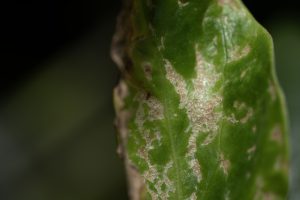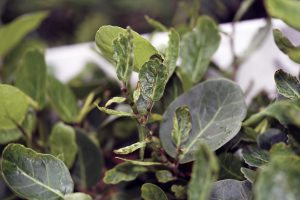Last Updated on March 29, 2023 by Tory Moore
An invasive thrips species has started to wreak havoc in Florida. The insect was first detected in Florida in 2020 but has since spread significantly across the state. What once was isolated to greenhouses now has begun to harm a wide range of plants including those in residential landscapes.
The insect, Thrips parvispinus — commonly known as pepper thrips — is one of the smallest thrips species in Florida. Its size makes it challenging to detect. The tiny insects fly and hop from plant to plant, rasping the plant with their mouth parts and sucking the sap. Feeding on the plant restricts the plant’s growth and reduces crop yields. Researchers don’t know of any viruses this species transmits, but often, thrips can transmit viruses between plants, killing the plants.
“In order to minimize any kind of negative impacts we started warning people right away that this pest had made its way to Florida,” said Lance Osborne, UF/IFAS entomologist at the Mid-Florida Research and Education Center. “We better be careful. This insect is notorious for damaging peppers around the world but now it has moved from the greenhouse to the environment and has established itself in several areas around the state.”

Currently, scientists don’t know of any effective predators or other biologicals that attack Thrips parvispinus in Florida and chemical control has been very difficult. That makes early detection and prevention even more important.
“While damage symptoms are the most noticeable indicators of its infestations, they may not appear until after the plant has sustained considerable harm,” said Muhammad “Zee” Ahmed, USDA research entomologist. “As they say, prevention is always better than cure, and this is particularly true when dealing with Thrips parvispinus.”
The research team including Ahmed, Cindy McKenzie of USDA, and UF/IFAS Extension agent John Roberts conducted a survey of garden centers in Palm Beach County to understand how widespread the pest is. Eight out of nine stores entomologists visited had the pest.
In November, a south Florida grower lost an entire pepper crop to the pest valued at more than $1.3 million.
“At first, the damage can mimic mites and can be misleading,” said Osborne. “The control methods are not the same and without proper treatment, these thrips can take out a whole crop.”
Entomologists encourage growers to scout often and inspect their plants carefully.
“It isn’t that the sky is falling but we have to pay attention to this and not ignore it,” said Osborne. “Growers of any crop should be aware. This insect seems to have a fairly broad host range. This won’t just impact peppers and ornamental plant growers.”
The pest has been detected on a wide variety of plants including 43 species from 19 plant families including fiber crops, vegetables and ornamental plants.
“Now that we know more about the insect, we need to do more research to know how to manage them,” said Osborne. “We want to help growers avoid wasting money and chemicals so we are working to develop effective spraying strategies for controlling their populations.”

Researchers are conducting controlled experiments in quarantine facilities including Alexandra Revynthi at the UF/IFAS Tropical Research and Education Center and Osborne at MREC. But scientists are eager to test their findings in real-word scenarios.
The regulations for research on controlled pests of this kind are strict. Scientists cannot move plant material or the live insects outside of infested areas, or work with them in university facilities accept in an approved quarantine room. These quarantine rooms are very small and not much different than a broom closet, which makes testing difficult.
“We are hearing that some things may work to control these thrips, but we need to conduct research to validate what we are hearing,” said Osborne. “I may find something to be successful when testing it here in a small room with artificial lighting, but it might not work in a greenhouse, landscape or vegetable field. We’re interested in working with growers to help manage the pest so we can better understand how to treat these thrips in a commercial setting.”
Growers who detect Thrips parvispisnus should immediately report their findings to the Florida Department of Agriculture and Consumer Services Division of Plant Industry. Then, researchers can work with growers to help manage the pest and develop the best treatment options available.
A new website developed in collaboration between UF/IFAS and USDA provides detailed information on the insect’s biology, early detection, and damage symptoms with detailed videos and images.
“This information will be critical in developing effective control strategies and preventing the further spread of this invasive species in the U.S.,” said Ahmed.
 1
1
